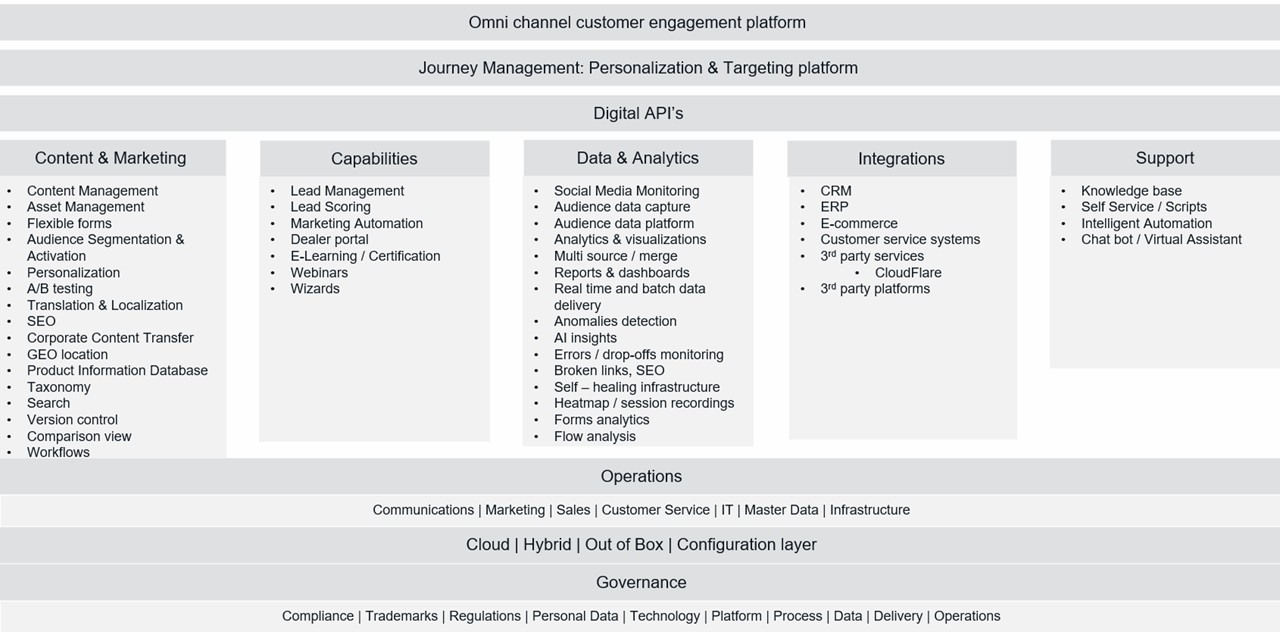In today's rapidly moving world of disruptive technologies, multiple communication platforms, and diverse customer profiles, it is critical for global or otherwise large organizations to effectively and efficiently deliver, manage, measure, and archive content. Often across regions and in a number of languages.
That task is complicated by the need to provide flexibility for the various geographies. They need to work with local agencies to implement messaging for specific audience types or certain market segments while ensuring consistency with corporate brand guidelines.
And on top of all those considerations is the need to look for opportunities to reduce costs, streamline the approval workflow, and plan for maintenance.
Sound familiar? Sound challenging?
Consider this article a helping hand. It will illustrate how—with the right set of tools and process in place, and a willingness to embrace change—it can be done.
The days of putting up a few webpages and sending emails are long gone. Today's savvy communication professionals understand that a robust content management system (CMS) is a critical tool. But there are myriad systems on the market. How does one choose the right set of tools and what needs to be considered in the selection process?
It is a major undertaking that should be addressed strategically and thoughtfully to ensure the systems you choose meet your needs today and are scalable for the future.
Start With a Vision
Understanding what good looks like helps in researching your communications platform. For a project that will ultimately involve multiple stakeholders and capabilities (Sales, Marketing, Legal, Information Systems, Compliance, etc.) it always helps if the team can refer to a vision.
Don't make your vision too complicated or, for that matter, too broad; but do ensure that it aligns with the company's overall vision, and make it specific to the project at hand.
In your vision statement, outline what the team wants to achieve, explain the value that will be created for the organization, and use enough detail that the team can feel engaged and accomplished as you move through the process.
Here's an example: "Create a single, global, easy-to-manage communication platform with powerful imagery and consistent look and feel. This platform will enable effective and efficient marketing campaigns to current and prospective customers. Those campaigns will be both scalable and adaptable to company product and market changes."
If You Build It... Digital Tools to Consider

Digital presence landscape
Clearly, the CMS you select should meet your goals, but it helps to start the process with some guidelines.
Essential requirements for B2B content management systems include the following:
- Website performance expectations. How many concurrent visitors you could have determines how fast your website should be and what type of content delivery methods are needed to match those expectations. For example, static pages published on a document-type database usually have fastest content delivery speeds, but you miss the ability to deliver dynamically filtered content. Some trade-offs may be necessary, even at this early stage.
- Number of channels for content distribution. Let's say your site will need to allow you to generate PDFs of pages, or post content to a third-party site. In that case, look for a headless or hybrid CMS platform that would allow you to separate content from its representation layer.
- Sections vs. page templates. Working with individual page sections elements or "components" instead of hard-coded page templates gives content editors a great level of flexibility to work with sections as "building blocks" and make the pages they need by using a predefined list of configured components. Each region can tailor its unique marketing messaging while staying in compliance with overall brand guidelines.
- Global content transfer. This is the ability to establish subscription links to content packages across the regional versions of the website. This is especially useful when you'd like consistency in certain areas of the website across the regions or languages. Such examples could be legal pages, such as policies, or corporate information pages—think "About Us" or "History."
- Ease of integration. It is critically important to have a variety of built-in connectors to other platforms and systems to fully leverage a "best-of-breed" approach in the areas where CMS is not of a good fit. For example, services like Zapier can significantly extend functionality of your website by leveraging integration between thousands of platforms, including e-commerce, establishing intuitive workflows and reducing maintenance costs.
- Secure Cloud technology. Using tools the way they are meant to be used and avoiding custom programming provides global configuration flexibility. Going forward with highly configurable Cloud solutions will ensure that your tools are updated and patched on a regular basis without a need to constantly invest in them. Without this, custom "Band-Aids" are needed because "this is how we've always done it," which means there are many wasteful programs that are only relevant to one region. Stop technical depth! It kills your scalability.
- Miscellaneous features. Among these are content personalization, A/B content testing capability, content version control, flexible approval workflows, and overall internal notifications systems.
Besides CMS functionality itself, it is important to integrate other systems that can be considered "best in class" for global websites.
Here are some other, equally important, aspects of your communication platform to consider:
- Translations. Think globally, act locally. It sounds cliché; however, it's very possible for someone on the other side of the world to search out your content. Even if you don't think you need translation, it makes sense. Consider a CMS that has an automated translation process across the website (and one that can integrate with local and global third-party agencies). It could be as simple as generating an XML file for translation agencies to work with, or full integration with an automated translation service like www.deepl.com.
- Integration with marketing automation systems. Data is king. You want a system that not only tracks what visitors do on your website but also how you interact with them via forms, emails, and social media ads. Look at each campaign as an opportunity to learn what works well and what is not moving the needle.
- Search. Elastic website search capability (fastest internal website search functionality) is key. Customers do not want to struggle to find what they're looking for. Nor do employees on the back end. Make sure your search capability is robust to complement your navigation.
- Single source of truth. This is particularly important for manufacturers of multiple products across many regions. Your product information database, whether it is located within your enterprise resource planning (ERP) or is part of the customer resource management (CRM) systems, should include product performance values, marketing product data, standards, warranties, and manufacturing options. Legal likes this, and so does the sales team.
- Taxonomy. Yes, there's a science to this! Every company/industry has common terms unique to its product base. Having a database of these keywords, synonyms, and tags that are unified and translated into different languages improves search capabilities. A good example would be to define your competitor's product names as synonyms to your product names, so in case a visitor is not familiar with your particular nomenclature you would still be able to showcase your relevant products instead of a "no results found" message.
- Digital asset management. Webpages, marketing campaigns, email campaigns, etc. always need updating. An asset bank is that place where all digital photos, collateral, videos, etc. are stored, with appropriate permissions in place, to be used across regions. This is not an inexpensive undertaking, but consider the long-term opportunity costs. An efficient bank improves organization, allows employees to find resources quickly, and limits risks such as copyright issues.
- Forms. Advanced forms management provides a great level of flexibility in terms of defining forms logic, sophisticated conditional dependencies, insightful analytics, reports, and integration with CRM and marketing automation platforms. A good example of this is www.logiforms.com.
Time and Money Well Spent
Your communication management platform will be the key to delivering an extraordinary customer experience and delivering the analytics your C-suite will appreciate.
Putting the hard work in at the beginning of selecting your tools will ultimately prove valuable when creating, maintaining, and updating your site; engaging with customers; helping the sales team; and reducing complexity, redundancy, and waste.




